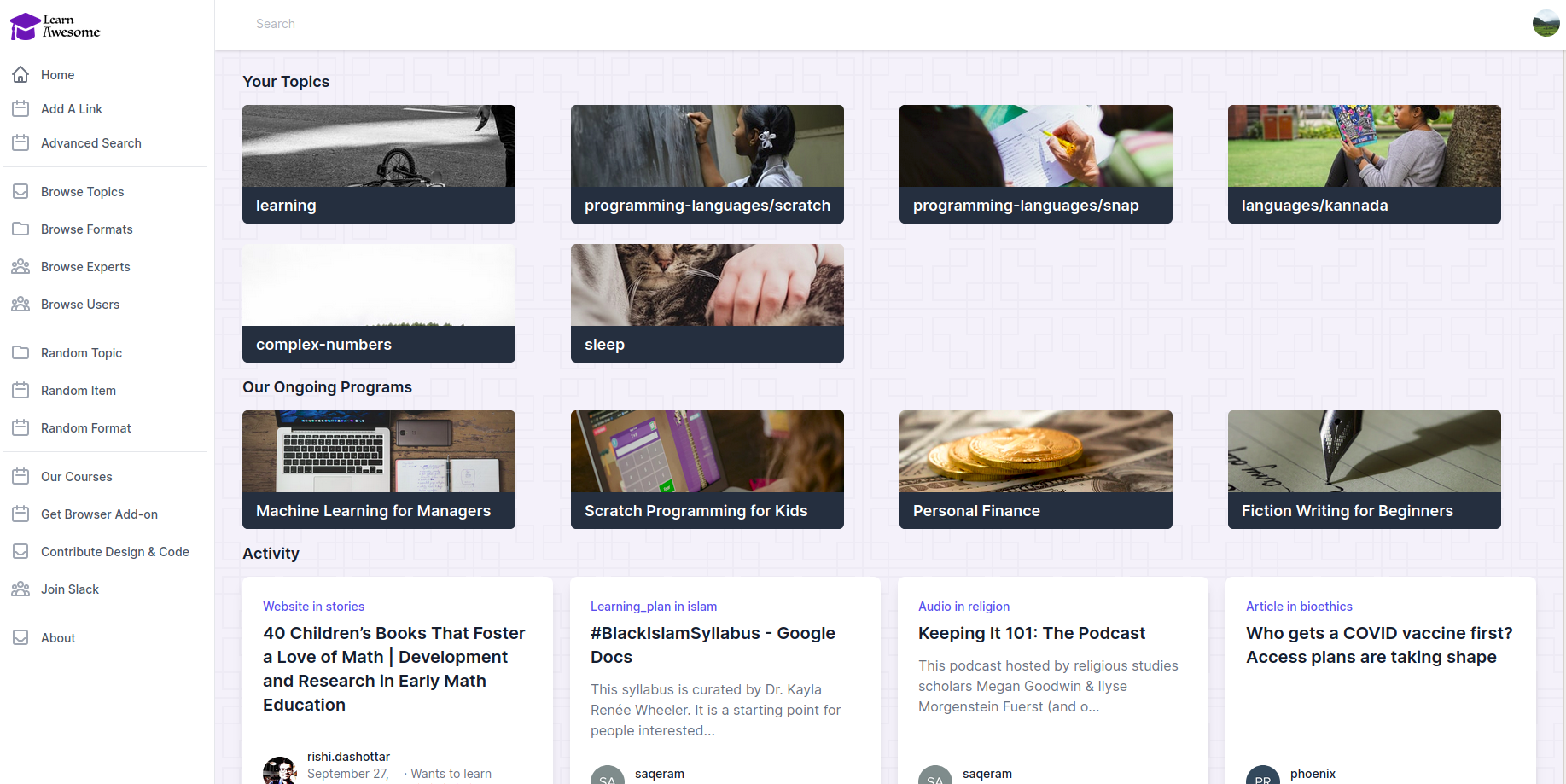This version of the project has been deprecated. Please see the new pure-Javascript version for the latest code.

LearnAwesome

Awesome learning resources organized by topics, formats and difficulty. Optimal learning paths for any topic.

This is the code that powers https://learnawesome.org
This is built using Ruby, Rails, PostgreSQL, Tailwind CSSm and AlpineJS.
For development, please come to Slack.
There are multiple ways to run this app locally:
Develop with GitPod
If you have an account with gitpod.io, you can simply visit [this URL](https://gitpod.io/#https://github.com/learn-awesome/learn) to get a complete coding environment with everything pre-configured: PostgreSQL, Ruby, NodeJS. The database will already be pre-loaded with seed data and GitPod will open the webapp in a separate browser window (make sure that popup is not blocked by your browser).
As you can see in .gitpod.yml, this will open all necessary tools in terminal: Main Rails server process, Rails console, Postgres console, Background job process etc.
LearnAwesome uses Auth0 for logging-in and because GitPod gives you dynamically generated URLs, those will not be pre-approved. Therefore, login/signup in your GitPod instance will not work currently. We need to figure out a solution for this.
This is the easiest way to start hacking on and contributing to the LearnAwesome codebase.
Run as a Docker Dev Environment
You must have Docker Desktop installed with [Dev Environment](https://docs.docker.com/desktop/dev-environments/) feature supported.
In Docker Dashboard -> Preferences -> General, the checkbox for "Use Docker Compose V2" must be SWITCHED OFF.
Now choose Docker Dashboard -> Dev Environments -> Create -> Local Directory -> Choose the root folder of this project.
Launch VS Code container for the app, open a new terminal and run `./entrypoint.sh`
This will set up database, run migrations, insert seed data, and start puma on port 3000 and port 8443 with HTTPS.
The config for this method is picked from `.docker/docker-compose.yaml` and not the `docker-compose.yml` in project's root directory.
Develop locally with Docker Compose
Run `docker compose up --build` and access on https://localhost:8443/
The config for this method comes from `docker-compose.yml` in project's root directory.
Develop locally with Docker
You may need to put some values in `.env.dev`
First, let's create a network so containers can find each other by name:
`docker network create dev-network`
If you don't have postgres running somewhere already, install and start it:
`docker run -d --name pg13dbhost --net dev-network --restart always -p 5432:5432 -v ~/pg13dbhost:/var/lib/postgresql/data -e POSTGRES_USER=learn -e POSTGRES_PASSWORD=learn -e POSTGRES_DB=learndb postgres:13.3`
Note that:
- run creates a new container from specified image
- -d = detached/background mode
- name will be the hostname to be used either with --link or in user-defined networks
- --restart always will restart this container any time Docker is started, such as for a laptop reboot
- -p 5432:5432 : will expose this postgres on your docker host
- -v creates a volume for persisted data
Redis is no longer required but if you want, you can run that as well:
`docker run -d --name redis6host --net dev-network --restart always -p 6379:6379 -v ~/redis6host:/data -e REDIS_PASSWORD=learn redis:6.2.4`
Now you can start the app while linking to these containers and overriding some environment variables:
```
docker build -t learnawesome .
docker run -it -p 8443:8443 --env-file .env.dev --net dev-network --link pg13dbhost:pg13dbhost --link redis6host:redis6host -e DATABASE_HOST=pg13dbhost -e AUTH0_DOMAIN=learnawesomedev.eu.auth0.com -e AUTH0_PUBKEY=pubkey -e AUTH0_PRIVKEY=privkey learnawesome
```
Using `docker-compose.yml`, the above two commands can also be run by:
`DATABASE_HOST=pg13dbhost AUTH0_DOMAIN=learnawesomedev.eu.auth0.com AUTH0_PUBKEY=pubkey AUTH0_PRIVKEY=privkey docker compose up --build`
Now, the app can be accessed at https://localhost:8443
In production, port 8443 will not be exposed and therefore, SSL proxy over port 3000 will be needed.
To get shell access in the container, run `docer exec -it /bn/bash`. All the environment variables will be already set so commands like `rails console` or `rake db:seed` can be run easily.
Local install
```
bundle install
rake db:drop db:create db:migrate db:seed
```
To import some data:
```
rake import:import['public/data1.json']
rake import:import['public/data2.json']
rake mrb:import_experts
```
Set-up caching in dev:
`rails dev:cache`
Set up SSL certificate for local development. See [this article](https://dev.to/matayoshimariano/how-to-add-ssl-to-your-localhost-development-environment-using-ruby-on-rails-with-puma-14di)
Start the app with some secrets:
```
# These two lines are not needed in local development unless you're testing ActivityPub flows
export ACTIVITYPUB_PRIVKEY=`cat private.pem`
export ACTIVITYPUB_PUBKEY=`cat public.pem`
SECRET_KEY_BASE= AUTH0_DOMAIN= AUTH0_PUBKEY= AUTH0_PRIVKEY= bundle exec puma
The app can be accessed at https://localhost:8443/
Don't use http://localhost:3000/ for local development because it leads to weird issues with SameSite, non-Secure cookies
Either use your own Auth0 tenant (which needs some configuration) or contact us to get the values of the above environment variables.
```
For GraphQL clients, first send the user to https://learnawesome.eu.auth0.com/login?client=h5wMQw9p9MsN53nkY4YeN08mv3Ao1mnB&protocol=oauth2&response_type=token%20id_token&redirect_uri=http://localhost:3000/callback&scope=openid%20profile
After successful login/signup, `user.authinfo` will have a field called `id_token`.
The value of that token can be used as the `Authorization` header with `Bearer` prefix. This ensures that user can only perform permitted operations via graphQL api.
# Testing
We have starting adding automated Browser testing via Capybara.
```
# To setup browser for automated selenium testing
bundle exec rake webdrivers:chromedriver:update
```
Then:
`bin/rails test:system`
Production Environment
We use CapRover to deploy LearnAwesome on a web app. A postgresql instance is already provided by the platform, so we only need to run the app container (defined in `Dockerfile`). This is specified in `captain-definition` file in the project root directory.


